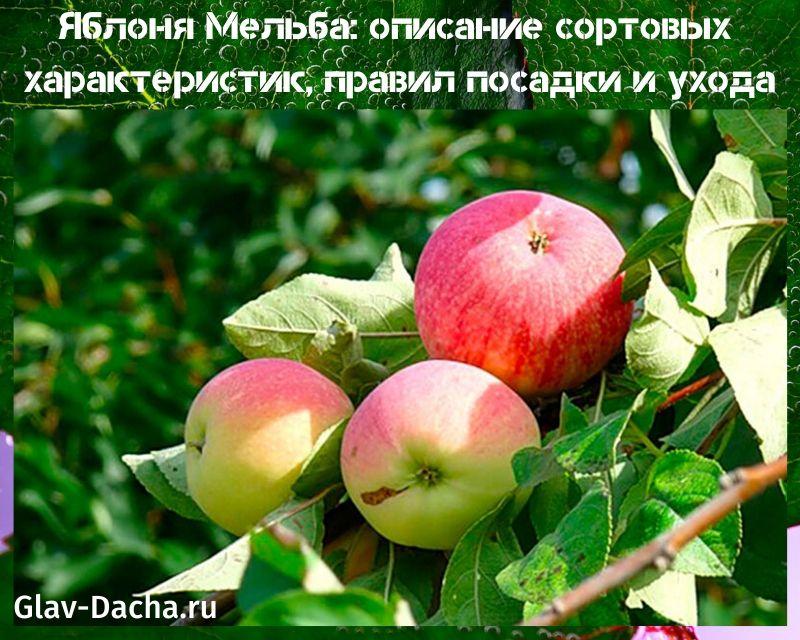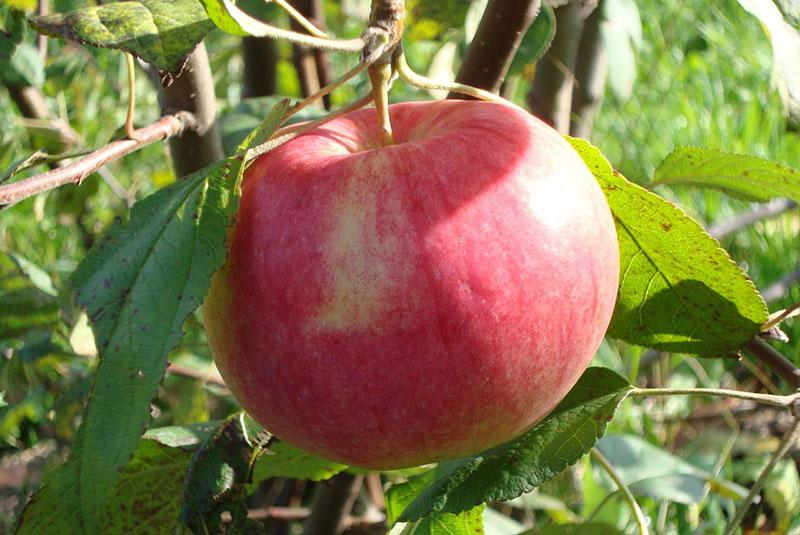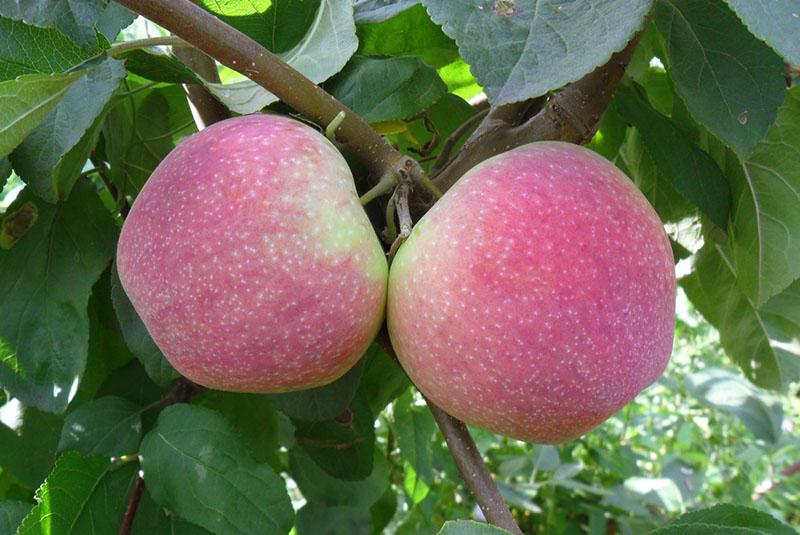Apple-tree Melba: description of varietal characteristics, planting and care rules
 In the garden at the summer cottage, there must be at least a few favorite varieties of apple trees. A worthy place is occupied by the Melba apple tree, a description of which we will provide you today. A close acquaintance with the varietal characteristics of the tree will come in handy when choosing an apple tree seedling and growing it in order to get a decent harvest.
In the garden at the summer cottage, there must be at least a few favorite varieties of apple trees. A worthy place is occupied by the Melba apple tree, a description of which we will provide you today. A close acquaintance with the varietal characteristics of the tree will come in handy when choosing an apple tree seedling and growing it in order to get a decent harvest.
How the variety was bred

Today, there are a huge number of apple varieties in the gardens, but the Melba variety still occupies an honorable place in public and private gardens. Excellent varietal qualities are used by breeders to obtain more and more apple hybrids.
Read also:apple lungwort description with photo!
Apple tree Melba: description of fruits and tree

The tree has a compact crown size, which is important with a small area of the summer cottage:
- The maximum tree height is 4 m. The trunk of an adult tree is covered with dark brown bark with a reddish or orange tint.
- Spreading round, slightly elongated crown in width is no more than 7 m. The branches are not very thick and grow a little down. The light green foliage is oblong.

- The Melba variety blooms in the month of April. There is a pleasant, delicate aroma around the white-pink crown with large flowers.

- Although it is a self-fertile variety, so that the tree gives a good harvest every year, the Melba seedling is planted next to other varieties of apple trees. Cross-pollination with apple trees of Kvinti, Bellefleur Kitayka or Antonovka gives good results.
The Melba apple tree grown on a dwarf rootstock will be more than 2 m in height.
Juicy fragrant fruits attract attention. They can be eaten fresh and used to make various delicious desserts.
Fruit characteristics:
- Ripe fruits are round in appearance, slightly flattened and elongated in shape. The average weight of one apple is 150 g.
- The dense skin is smooth and delicate to the touch. The fruits are yellow-green in color with a red blush and are covered with a thin waxy coating.
- The inside of the apple is white. The flesh tastes sweet and sour, juicy and gives off a candy aroma.
In the northern regions of Russia, gardeners are not recommended to grow Melba apple trees. The tree does not tolerate severe frosts, and the fruits do not have time to fully ripen.
Characteristics of the Melba apple tree
 In order for the garden to delight its owners with good harvests every year, it is necessary to carefully study the characteristics of the varieties of fruit trees you like. This applies not only to apple trees, but also to other fruit trees.
In order for the garden to delight its owners with good harvests every year, it is necessary to carefully study the characteristics of the varieties of fruit trees you like. This applies not only to apple trees, but also to other fruit trees.
The Melba apple variety is successfully grown in southern Russia and regions with a temperate climate.
Drought and winter hardiness:
- During dry, hot summers, mature trees need to be watered regularly. If the soil dries out during the ripening period, the fruits will begin to fall off and the yield will significantly decrease.
- The variety has an average winter hardiness. In regions where frost does not fall below -30 ° C in winter, trees do not need any shelter.
The Melba apple trees ripen late and this must be taken into account when choosing seedlings and planting sites.
Maturation features:
- in the orchards of the southern regions, ripe apples are picked at the end of July;
- the first wave of the harvest in temperate climates can be harvested after August 15;
- on trees growing in the shade, fruits ripen 1.5 later;
- fully ripe apples fall to the ground.

Melba yield and fruiting:
- the first fruits appear 5 years after planting the tree;
- a young tree for the first 10 years gives a crop every year weighing up to 50 kg;
- in an older tree, the years of a high harvest alternate with years of rest;
- the variety is characterized by uneven ripening, the more light the tree receives, the more amicably the fruits ripen;
- the yield will be low if there are no pollinating apple trees nearby;
- the maximum yield from one tree is 150 kg;
- the maximum age of the Melba apple tree is 80 years.

The following varieties are best suited as pollinators for the Melba variety: Antonovka, Stark erlist, Borovinka, Quinti, Belfer-Kitayka or Suislepskoe.
Ripe fruits have a good presentation. They perfectly tolerate transportation and are stored for a long time after it. The presentation of apples and their taste do not change when stored in a cool dark place. It is these characteristics that contribute to the cultivation of the Melba variety on an industrial scale.
One of the disadvantages of the Melba variety is its instability to scab. Successful cultivation will require regular preventive measures to prevent damage.
Apple-tree Melba: description of growing conditions

When choosing seedlings and growing them, it is necessary to take into account the regional characteristics of the climate, the location of the site, the quality of the soil and other requirements:
- Apple trees do not grow well in areas with high groundwater levels. Do not plant trees in a low place of an inclined area to avoid root rot from stagnant rain and melt water.
- The Melba apple variety simply needs a lot of heat and sun. Therefore, it is necessary to find a place on the southeast or south side of the site.
- For a good development of the root system, a loose soil containing sand and clay is needed.
- For seedlings and young trees to get enough nutrients, you need fertile soil with neutral acidity.
- A place well lit by the sun is a guarantee of full ripening of fruits with sweet aromatic pulp.
- A strong tree will grow in a place protected from drafts and cold winds.
- The distance between the apple tree and other nearby growing trees should be at least 5 m. At the same distance, it is necessary to plant the Melba variety from tall structures.
The groundwater level in the area for the apple orchard must be at least 1.5 m.
 When buying seedlings, you need to pay attention to the development of the root system, the integrity of the trunk. Annual seedlings are still weak to transplant. Two-year-old trees are best suited for transplanting. Younger trees have a well-formed root system and may be damaged during transplantation, which will lead to the death of the plant.
When buying seedlings, you need to pay attention to the development of the root system, the integrity of the trunk. Annual seedlings are still weak to transplant. Two-year-old trees are best suited for transplanting. Younger trees have a well-formed root system and may be damaged during transplantation, which will lead to the death of the plant.
If your area has snowy and moderately cold winters, it is better to plant young trees in late September or early October. The apple tree will have time to take root if you plant it a month before the first subzero temperature.
In regions with more severe cold winters, apple trees are preferably planted in the spring. Landing time is April. It is necessary to have time to plant a seedling before bud break.
Purchased seedlings with an open root system must first be placed in a bucket of water for 2 days. On the day of planting, dip the root system in a mixture of clay, water and cow dung.
Planting rules for Melba apple trees
 2 weeks before buying a seedling, you need to choose a place for planting an apple tree and dig a planting hole 80 cm deep with sides up to 1 m.Divide the excavated soil into equal parts.
2 weeks before buying a seedling, you need to choose a place for planting an apple tree and dig a planting hole 80 cm deep with sides up to 1 m.Divide the excavated soil into equal parts.
Immediately from one part of the land, it is necessary to prepare a nutritious soil. To do this, add humus, peat and sand in the same amount as the soil.
You will also need:
- double superphosphate - 400 g;
- wood ash - 1 kg;
- potassium sulfate - 200 g.
Lay out a drainage layer from coarse sand, fine gravel and small pieces of brick at the bottom of the dug planting pit. Put a mound of prepared nutrient mixture on top of the drain. In this form, the pit should stand until the planting of the seedling.
 On the day of planting, drive a strong peg into the bottom of the pit from the north side. It will further serve as a support for the apple seedling.
On the day of planting, drive a strong peg into the bottom of the pit from the north side. It will further serve as a support for the apple seedling.
Slightly dry the roots of the seedling, previously immersed in a clay-dung mixture. Place the tree on a nutritious mound and gently spread the roots.
The root collar of the seedling should be approximately the height of a matchbox above ground level.
Sprinkle the roots of the apple tree with loose soil. To avoid possible formation of voids between the roots, shake the seedling several times. The soil around the trunk must be compacted. Form an earthen roller at a distance of 50 cm from the tree.
 Tie a young apple tree to a support and water. Use rain or settled warm water for irrigation. For the first time, 2 buckets will be enough. Wait until the liquid is completely absorbed and sprinkle the wet soil with dry grass or peat. Mulching will protect the soil from premature drying out and cracking.
Tie a young apple tree to a support and water. Use rain or settled warm water for irrigation. For the first time, 2 buckets will be enough. Wait until the liquid is completely absorbed and sprinkle the wet soil with dry grass or peat. Mulching will protect the soil from premature drying out and cracking.
What kind of care does the Melba apple tree need?
 Like other trees in the apple garden, apple trees need regular pruning, spring whitewashing of trunks, mulching of the trunk circle, watering and fertilizing.
Like other trees in the apple garden, apple trees need regular pruning, spring whitewashing of trunks, mulching of the trunk circle, watering and fertilizing.
Features of tree care:
- As soon as the buds come to life on the tree, it is necessary to start watering. This must be done once a month. The last time to water is in September.
- For a seedling, it is enough to use 2 buckets of water at a time. When the tree begins to bear fruit, the amount of water must be increased to 4-6 buckets.

- To keep the soil moist for as long as possible, after each watering, the soil is covered with dry grass, straw or fallen leaves. Before watering, the mulch is removed from the trunk.
- A year after planting the seedling, it is necessary to feed the tree for the first time. Fertilize in the month of May. To do this, dissolve 500 g of urea in a bucket of water (10 l). After 2-3 weeks (early June) repeat the procedure.
- In the last decade of July, prepare a solution of chicken manure (1 part) with water (12 parts). When not chicken manure, you can use cow dung in a ratio of 1 to 8 to water.
- Digging up the earth in the fall in the garden, you need to add a nutritional composition under each tree. To do this, add 700 g of wood ash, 100 g of superphosphate and 50 g of potassium sulfate to a bucket of peat.

- A year after planting the seedling, prune it, forming the crown of the tree. The procedure must be carried out before the start of sap flow.
- Strengthen the branches of an adult fruit-bearing tree by installing supports. This will prevent the branches from breaking off under the weight of the crop.
- Whitewash the trunk twice a year to protect the tree from pests, icing of the bark and sunburn.

- In winter, to protect the tree from rodents and frosting, it is necessary to wrap the trunk with layers of burlap and straw. Use a rope for fastening.
- As soon as the first snow falls, form a snowdrift around the trunk to protect the plant on frosty days.
Find a spot in your garden for a Melba apple tree. After four years, the first delicious fragrant juicy fruits will appear on your table.